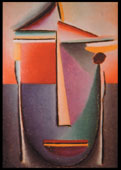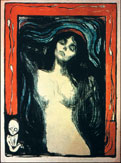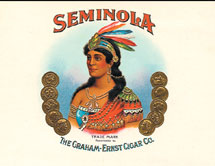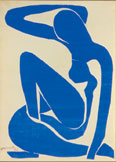
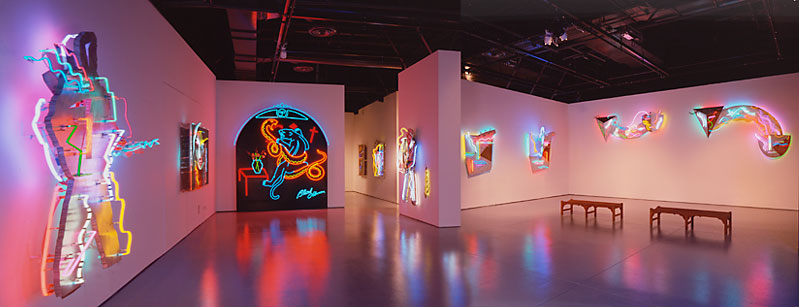

Installation
view, Sirens and Other Neon Seductions,
Art Galleries, California State University, Northridge, California
February 17–March 31. 2001
LILI
LAKICH: Sirens &
Other
Neon Seductions
Catalog
essay by Louise Lewis
In
a dazzling array of light, the CSUN Art Galleries discard the last vestiges
of the 1994 earthquake and celebrate their physical rebirth in new facilities
with Lili Lakich: Sirens & Other Neon Seductions.
The artist's invigorating and provocative imagery acclaims the architectural
setting of the exhibition with both individual works and her premier installation
piece, Sirens.
In paying tribute to Lakich, whose work has helped
keep neon sculpture alive in the art world without divorcing it from its populist
origins, the CSUN Art Galleries also herald her move into the realm of installation
art. A genre that is enjoying considerable popularity at the turn of the twenty-first
century, installation art forces reconsideration of both the artist's and
museum's utilization of architectural space and their re-vision of art/life.
Life one hundred years ago, at the beginning of the
twentieth century, was characterized by the phenomenal growth of urban populations,
consumerism, and leisure time, enhanced by the continued advances of the machine
age. The addition of electricity to the urban grid increased the range of
nightlife activities and enhanced a city's magnetism. In 1912 the Frenchman
Georges Claude invented a process to utilize neon (from the Greek word for
new) as a versatile lighting alternative to Edison's incandescent light, originally
seeing it solely as architectural embellishment. His partners convinced him
of neon's potential for advertising signage, and soon Claude had a virtual
monopoly on neon produced in Europe and abroad. In 1923 neon was introduced
in the United States by a Los Angeles car dealership, and soon thereafter
became the American medium of choice for municipal outdoor advertising.
Neon enjoyed its heyday in this country
from the thirties to just after World War II. The surplus of electrical power
allowed extravagant displays of kinetic imagery to enliven commercial and
entertainment districts of major urban centers, as well as small town oases
dotting the desolate stretches of the American Plains and Southwest. Just
after mid-century, however, neon lost favor to plastic and fluorescent signs
and did not see a resurgence until artists such as Chryssa, Martial Rayssé,
Keith Sonnier, Bruce Nauman and others introduced it to the world of art.
Lili Lakich created her first light sculpture, a
self-portrait with lighted teardrop, in 1966, while she was a student at Pratt
Institute in Brooklyn, New York. At the time artists such as Chryssa and Rayssé
were exhibiting their pioneering works in neon in New York galleries, and
influenced by their example, Lakich opted to work in this still experimental
art medium.
Lakich moved from New York to San Francisco, and
ultimately settled in Los Angeles in 1968. In this city, site of the first
American neon sign, Lakich was to bestow another hallmark in neon history
when she co-founded with Richard Jenkins the Museum of Neon Art (MONA) in
1981, dedicated to both the preservation of historic signs and the exhibition
of contemporary neon sculpture. At this time she enjoyed tangible success
with experimental works of her own for exhibition and with commissions for
private collectors and business enterprises. Throughout her career, Lakich
has maintained this tenuous balance between “high” and “low”
art, never losing her attraction to popular and even garish signs enjoyed
since her childhood, while simultaneously exploring the conceptual possibilities
of neon in combination with metal sculpture.
The vital alliance between vernacular
and vanguard applications of neon in Lakich's mixed media sculpture is one
of several recurring themes in her work. Others are autobiographical references
to her nighttime travels across this country and in Europe with the corollary
interest in environmental spaces, the emotional tolls and rewards of personal
relationships, thematic variations of international art historical masterpieces
(African masks, Byzantine icons, Japanese woodblocks, Italian Renaissance
and Modernist paintings), and a witty, sometimes acerbic, tone in her social
commentary.
The artist's first major sculptures were large wall
reliefs, neon drawings on heavy black metal supports. Utilizing popular symbols
such as military insignia, product logos, and tattoo designs, these reliefs
reflect influences of popular signage with their bright and glossy aura. In
Scar (1974) the panther
is borrowed from an embroidered army patch, the skull and cross bones by a
tattoo pattern, and the blood drops by the sperm border of Edvard Munch’s
Madonna (1895-1902). Similarly, Blessed
Oblivion (1975) mimics a tattoo emblem of a panther entwined
by a python, with the whimsical addition of a neon vase to complete the spatial
arrangement. In a more psychological tone Love
in Vain (1977) contains a photographic enlargement of
a heroin addict from Life magazine, altered with dissonant neon lines to become
the tortured form of female-as-chair in a private hell.
Finding the large metal frames a difficult format
to transport and install, Lakich began working in smaller formats, initially
keeping metal as the support backing. Her series on European art icons, specifically,
Mona (1981) after Leonardo,
Venus (1983) after
Botticelli, and Woman in Film
(1989) after an unsigned engraving from the Pre-Raphaelite School maintained
the rectangular format of the originals, but jolted the imagery into a new
world of flash and electric color.
When she discovered the versatility
of honeycomb aluminum, Lakich broke from the rectangular format of earlier
works and extended her range with a variety of sculptural shapes. The appropriation
of widely recognized art images takes a much more experimental turn with her
Icons series, in which honeycomb aluminum serves as the sculptural matrix
upon which neon lines create faces evocative at the same time of Western and
non-Western sources. Holy Ghost
(1983) utilizes the reductionist lines and geometric shapes of one of Jawlensky
's constructivist heads. Saving Grace II
(1984) reverses the aluminum base of Holy
Ghost, incorporates more colored neon, and inserts an
electrical conduit to suggest the crown of thorns of Christ, borrowing from
the richness of the Byzantine religious imagery of the Serbian Orthodox Church.
Inspired by masks from the Ivory Coast and Mali, Mambo
(1992) overlays the same aluminum head base with highly ornate and abstracted
shapes denoting facial features.
Icons of more recent vintage, that is, products of
the mass media, are the subject of Lakich’s sculptural homage to rock
and roll. Chuck Berry is venerated in The
Ghost of Rock ‘n’ Roll (1987), a variation
on a Japanese print by Toyokuni, and a publicity photograph of the music great,
amplified with the addition of an actual guitar. Elvis
II (1988) harks back to the era of the fifties and sixties
with boomerang shapes, crackle neon tube, vibrant wavy lines and the King's
trademark stance. The spectacle of these media icons with their stringed instruments
brings to mind the ingenious neon violins and pianos “played”
by chorines in Busby Berkeley's Goldiggers of 1933, one of the earliest
uses of neon in a Hollywood extravaganza.
In contrast to the more public images of the Icons, the
Portrait series affirms Lakich's introspective nature. In visual tributes
to lovers in her past, Lakich reveals unique traits of each person. With
The Warrior: Portrait of Robin Tyler (1980)
Tyler's spare, multi-hued profile floated on a rectangular copper base echoes
the strength seen in a cigar box adaption of an Amerindian chieftain.
Donna Impaled as a Constellation (1983;
drawing, 1982) is a bittersweet interpretation of the subject's interest in
cosmology; the diagonal figural silhouette is pierced with straight and curved
glass lines suggesting an ephemeral stellar outline. Mary Carter is the subject
of two portrait studies in this exhibition: Requiem
II (1988) is strongly metaphoric, portraying a Christ
figure with crown of thorns and chest wound, and suggesting the religious
preoccupations of this long-term companion of the artist. Sweetheart
(1993), also a half-torso figure, is a sculptural valentine, its curves, bold
patterns, bright colors, and pose reminiscent of one of Henri Matisse's nude
cutouts.
The AIDS series underscores Lakich's
humanitarian and activist involvement through her art. In her essay on the
responsibility of artists to society, Martha Rosler states, “The immediacy
of AIDS activism and its evident relevance to all levels of the art world,
including museum staff, brought politicized art far more deeply into the art
world than, for example, earlier feminist activism had.”1


Chryssa
Fragments for Gates to Times Square II, 1966, programmed neon/plexiglass
Whitney Museum of American Art, New York

